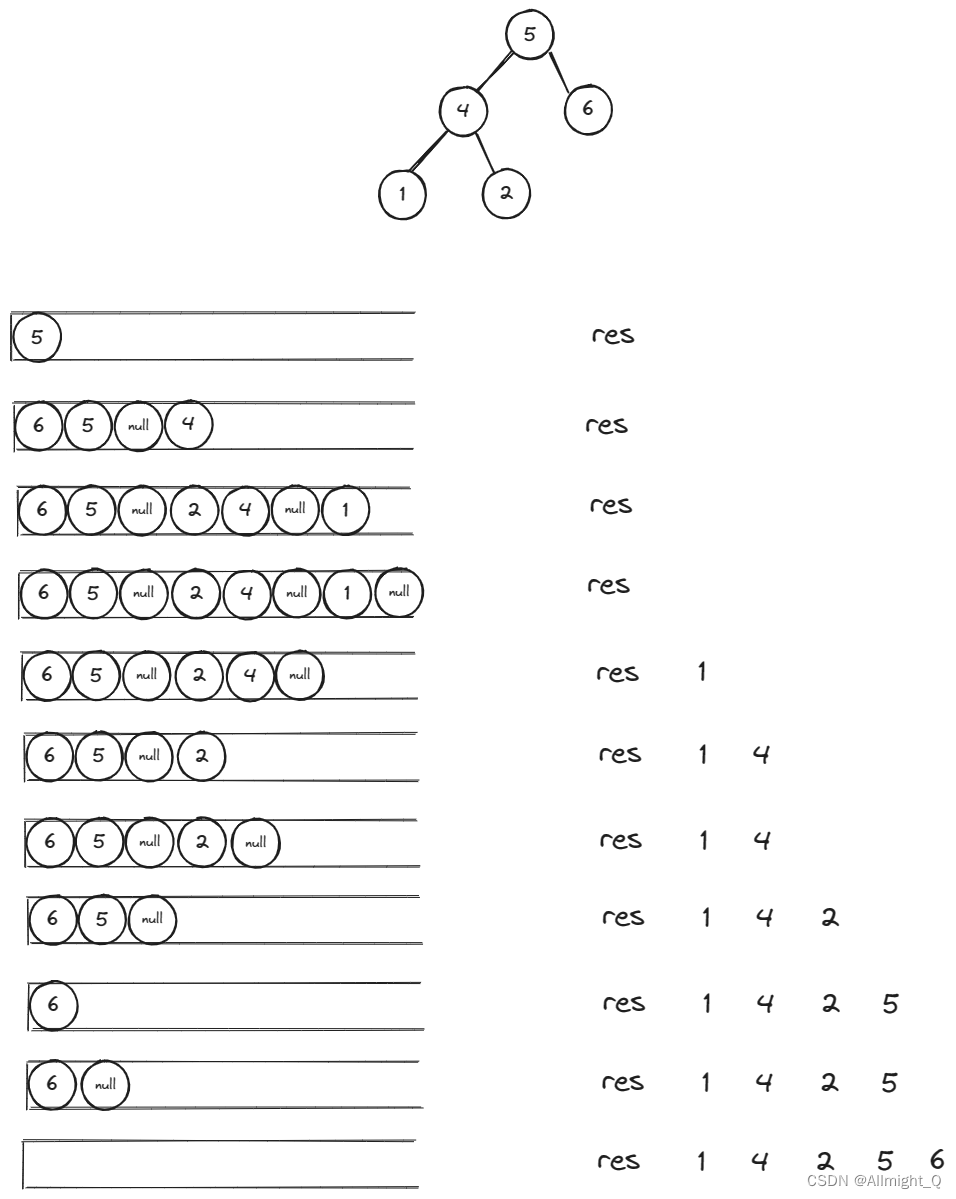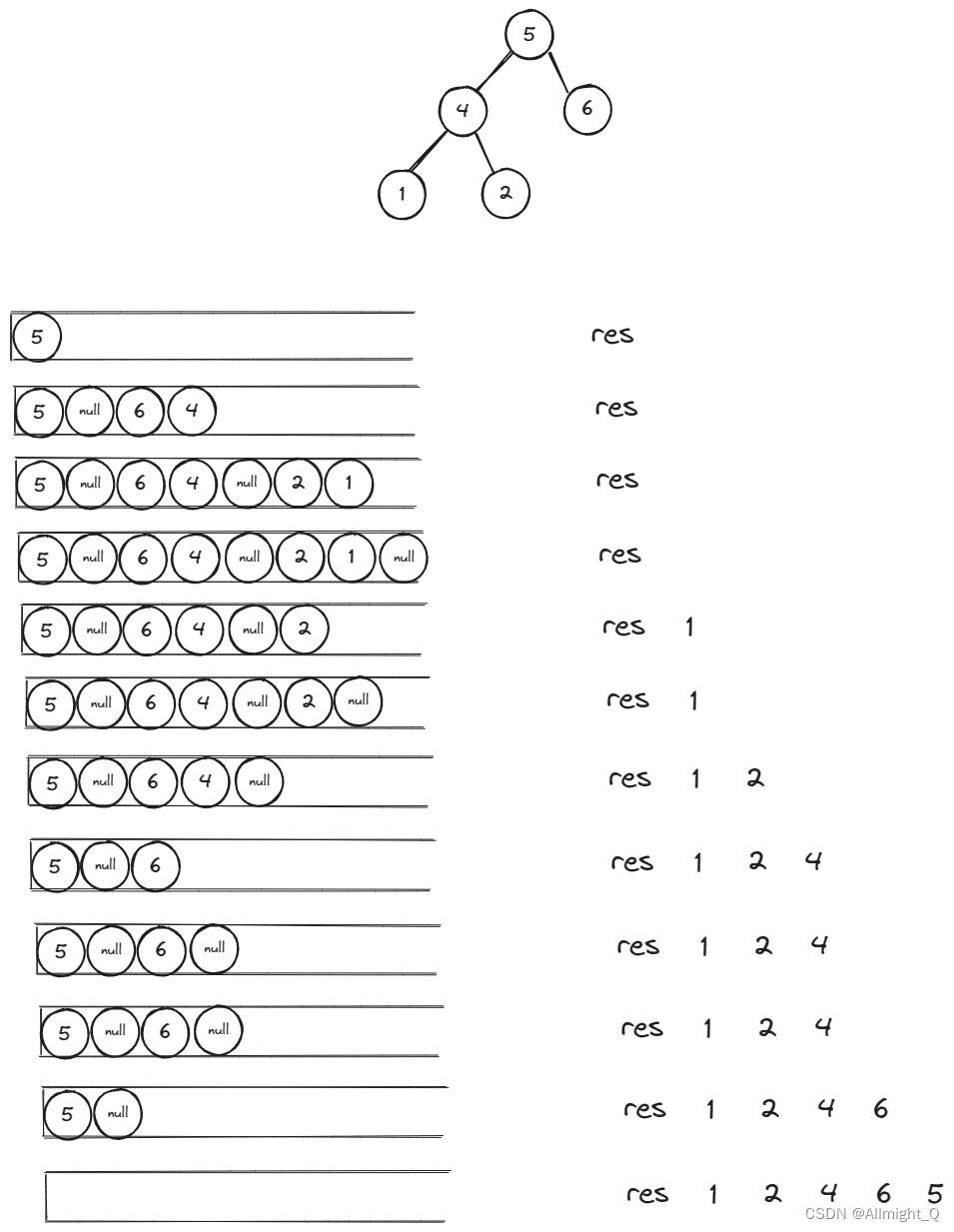本文主要是介绍【算法刷题day14】Leetcode:144.二叉树的前序遍历、94.二叉树的中序遍历、145.二叉树的后序遍历,希望对大家解决编程问题提供一定的参考价值,需要的开发者们随着小编来一起学习吧!
文章目录
- 二叉树递归遍历
- 解题思路
- 代码
- 总结
- 二叉树的迭代遍历
- 解题思路
- 代码
- 总结
- 二叉树的统一迭代法
- 解题思路
- 代码
- 总结
草稿图网站
java的Deque
二叉树递归遍历
题目:
144.二叉树的前序遍历
94.二叉树的中序遍历
145.二叉树的后序遍历
解析:代码随想录解析
解题思路
递归遍历
前序:NLR
中序:LNR
后序:LRN
代码
/*** Definition for a binary tree node.* public class TreeNode {* int val;* TreeNode left;* TreeNode right;* TreeNode() {}* TreeNode(int val) { this.val = val; }* TreeNode(int val, TreeNode left, TreeNode right) {* this.val = val;* this.left = left;* this.right = right;* }* }*/
//前序
class Solution {public List<Integer> preorderTraversal(TreeNode root) {List<Integer> res = new ArrayList<Integer>();preorder(root, res);return res;}public void preorder(TreeNode root, List<Integer> res){if (root == null)return;res.add(root.val);preorder(root.left, res);preorder(root.right, res);}
}//中序
class Solution {public List<Integer> inorderTraversal(TreeNode root) {List<Integer> res = new ArrayList<Integer>();inorder(root, res);return res;}public void inorder(TreeNode root, List<Integer> res){if (root == null)return;inorder(root.left, res);res.add(root.val);inorder(root.right, res);}
}
//后序
class Solution {public List<Integer> postorderTraversal(TreeNode root) {List<Integer> res = new ArrayList<Integer>();postorder(root, res);return res;}public void postorder(TreeNode root, List<Integer> res){if (root == null)return;postorder(root.left, res);postorder(root.right, res);res.add(root.val);}
}
总结
暂无
二叉树的迭代遍历
题目:
144.二叉树的前序遍历
94.二叉树的中序遍历
145.二叉树的后序遍历
解析:代码随想录解析
解题思路
前序:利用一个栈,每次出栈并入栈。
中序:利用一个栈,cur指向root节点,一直走左子树并入栈到空;cur为空时输出栈顶的val,然后使cur指向出栈节点右子树,重复上述步骤。
后序:LRN反过来是NRL,也就是前序换一下,最后倒转一下。
代码
/*** Definition for a binary tree node.* public class TreeNode {* int val;* TreeNode left;* TreeNode right;* TreeNode() {}* TreeNode(int val) { this.val = val; }* TreeNode(int val, TreeNode left, TreeNode right) {* this.val = val;* this.left = left;* this.right = right;* }* }*///前序
class Solution {public List<Integer> preorderTraversal(TreeNode root) {List<Integer> res = new ArrayList<Integer>();if (root == null)return res;Stack<TreeNode> stack = new Stack<TreeNode>();stack.push(root);while(!stack.isEmpty()){TreeNode tmp = stack.pop();res.add(tmp.val);if (tmp.right != null)stack.push(tmp.right);if (tmp.left != null)stack.push(tmp.left);}return res;}
}//中序
class Solution {public List<Integer> inorderTraversal(TreeNode root) {List<Integer> res = new ArrayList<Integer>();if (root == null)return res;Stack<TreeNode> stack = new Stack<TreeNode>();TreeNode cur = root;while (!stack.isEmpty() || cur != null){if (cur != null){stack.push(cur);cur = cur.left;}else{cur = stack.pop();res.add(cur.val);cur = cur.right;}}return res;}
}//后序
class Solution {public List<Integer> postorderTraversal(TreeNode root) {List<Integer> res = new ArrayList<Integer>();if (root == null)return res;Stack<TreeNode> stack = new Stack<TreeNode>();stack.push(root);while(!stack.isEmpty()){TreeNode tmp = stack.pop();res.add(tmp.val);if (tmp.left != null)stack.push(tmp.left);if (tmp.right != null)stack.push(tmp.right);}Collections.reverse(res);return res;}
}
总结
死去的408记忆在攻击我
二叉树的统一迭代法
题目:
144.二叉树的前序遍历
94.二叉树的中序遍历
145.二叉树的后序遍历
解析:代码随想录解析
解题思路
代码结构和递归遍历相似。下面是模拟步骤图
前序

中序

后序:

代码
/*** Definition for a binary tree node.* public class TreeNode {* int val;* TreeNode left;* TreeNode right;* TreeNode() {}* TreeNode(int val) { this.val = val; }* TreeNode(int val, TreeNode left, TreeNode right) {* this.val = val;* this.left = left;* this.right = right;* }* }*///前序
class Solution {public List<Integer> preorderTraversal(TreeNode root) {List<Integer> res = new ArrayList<Integer>();if (root == null)return res;Stack<TreeNode> stack = new Stack<TreeNode>();stack.push(root);while(!stack.isEmpty()){TreeNode node = stack.peek();if (node != null){stack.pop();if (node.right != null) stack.push(node.right);if (node.left != null) stack.push(node.left);stack.push(node);stack.push(null); }else{stack.pop();node = stack.pop();res.add(node.val);}}return res;}
}//中序
class Solution {public List<Integer> inorderTraversal(TreeNode root) {List<Integer> res = new ArrayList<Integer>();if (root == null)return res;Stack<TreeNode> stack = new Stack<TreeNode>();stack.push(root);while(!stack.isEmpty()){TreeNode node = stack.peek();if (node != null){stack.pop();if (node.right != null) stack.push(node.right);stack.push(node);stack.push(null); if (node.left != null) stack.push(node.left);}else{stack.pop();node = stack.pop();res.add(node.val);}}return res;}
}//后序
class Solution {public List<Integer> postorderTraversal(TreeNode root) {List<Integer> res = new ArrayList<Integer>();if (root == null)return res;Stack<TreeNode> stack = new Stack<TreeNode>();stack.push(root);while(!stack.isEmpty()){TreeNode node = stack.peek();if (node != null){stack.pop();stack.push(node);stack.push(null); if (node.right != null) stack.push(node.right);if (node.left != null) stack.push(node.left);}else{stack.pop();node = stack.pop();res.add(node.val);}}return res;}
}
总结
感觉记住了,感觉。
这篇关于【算法刷题day14】Leetcode:144.二叉树的前序遍历、94.二叉树的中序遍历、145.二叉树的后序遍历的文章就介绍到这儿,希望我们推荐的文章对编程师们有所帮助!








